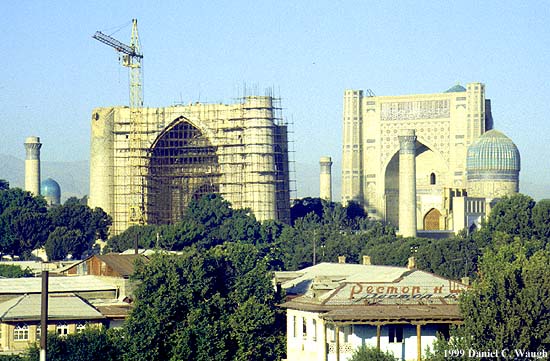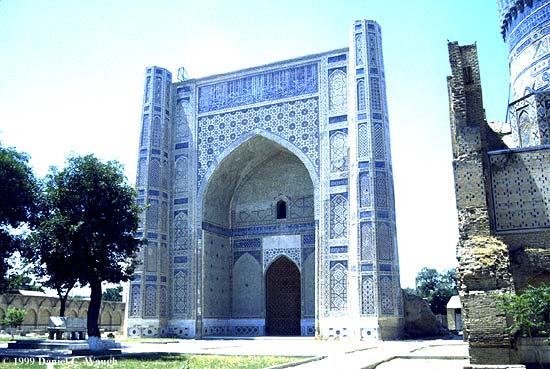Samarkand's status as the most important city in Central Asia, which it held for two millennia, rested not only on its proximity to water but also on its location at the crossroads of the Silk Road. All the different routes � west to the Mediterranean, east to China, and south to India � came together at Samarkand.
Money flowed from traveling merchants like the waters of the Zerafshan. And it was put to use enhancing the city. Public works projects, such as the building of irrigation canals, spacious plazas, and city walls, were undertaken, and Samarkand was well known as a city of gardens and orchards. Unfortunately, all that is left of the first 1,700 years of Samarkand's existence is a large mound and archaeological excavation, known as Afrasiab, the site of the city proper until Genghis Kahn destroyed it.
The architectural glories for which Samarkand is now known stem mostly from the efforts of Timur and his descendants (though parts of the marvelous Shah-i Zinda predate Timur, and several of the madrassahs on the Registan were erected by the Uzbeks in the 17th century). Timur, who was born not far away, chose Samarkand as his world capital in 1370, when he ruled Transoxiana, then set about conquering a world to rule from it. From each city that he conquered, he force-marched back to Samarkand the finest of its craftsmen � sculptors, stonemasons, and stucco workers from Persia and India; mosaic workers from Shiraz; glass blowers and potters from Damascus. He also brought back armorers and swordmakers � Timur had his practical side.
In the 14th and 15th centuries, Samarkand's urban architectural display must have been blinding to the new arrival. Huge mosques were built, like the Bibi Khanum, which survived only a few years before collapsing under the weight of its roof � and its builder's ambition. Great madrassahs were constructed, schools for the study of Islam, faced in glazed tiles of extraordinary beauty. And of course mausoleums eventually were needed for great teachers and saints, for cherished wives and children, and for the conquerors themselves.
The Timurid dynasty was really just Timur � his empire, vast as it was, was held together only by the force of his will to dominate others, and it survived for a short time after his death in 1405 simply because it was too large to fall apart instantly. Within a few years though the empire that had stretched from Turkey to India had been reduced to a few small states based around Bukhara and Samarkand.[www.gorp.com]
![Registon(gir.jpg)[www.gorp.com]](0108.jpg)




